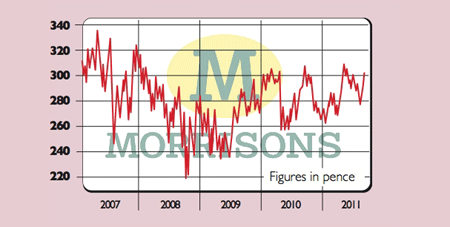
What is Morrisons?
Morrisons is the fourth-largest food retailer in Britain, with a market share of 11.7%. It has 456 stores with a total selling area of 12.4 million square feet and 296 petrol stations. It is also a significant food producer, which means it can supply many of its fresh food requirements in-house.
What is the company’s history?
The company was founded in 1899 when William Morrison opened an eggs and butter stall in Bradford market. After opening several more market stalls, the company opened its first supermarket in 1961 and listed on the stock exchange in 1967. During the 1980s and 1990s, Morrisons pursued a strategy of vertical integration by bringing increasing amounts of its fresh food production in-house. After more than 30 years of organic, profit-driven growth, Morrisons bought Safeway in 2004. However, that acquisition turned out to be quite a mouthful and took a large bite out of short-term profits. Since 2006, Morrisons’ profits have grown strongly as its low-cost business model has become increasingly popular with cash-strapped customers.
Who runs Morrisons?
Dalton Philips has been chief executive since March 2010. Prior to joining Morrisons he was chief operating officer of Loblaw, Canada’s largest food distributor. His total pay was £1.5m in 2010. Richard Pennycook is finance director, having previously been finance director of RAC plc. Sir Ian Gibson is chairman.
How is trading?
Despite tough trading conditions, Morrisons maintained its focus on fresh foods and various promotional strategies have enabled it to increase market share. For the six months to 31 July, sales increased by 7.4% to £8.7bn. Same-store sales – a key performance metric – increased by 2.2%. Operating profit increased by 8% to £442m, with earnings per share increasing by 9.7% to 11.91p. The interim dividend was raised by 10% to 3.17p.
What’s the outlook for Morrisons?
Quite challenging. Disposable incomes remain under pressure while the major food retailers continue to add new selling space. This increase in industry supply has the potential to dilute returns. That said, Morrisons’ vertically integrated (‘produce and sell’) business model gives it a cost and quality advantage in fresh foods. Meanwhile, Morrisons is looking to grow its online and convenience store sales from a very low base. The commitment to repurchase £1bn of its own shares and grow dividends by at least 10% per year for the next three years is also positive for shareholders.
The analysts
Of the 34 analysts surveyed by Bloomberg, 16 say “buy”, 14 “hold” and four “sell”. The average price target is 329p – 12% above the current share price. Most bullish is RBS, with a 389p price target, whereas Panmure Gordon is most bearish with a 300p target. Our view: on 11.7 times prospective earnings and with a growing dividend yield, Morrisons’ defensive characteristics look attractive.
The numbers
Stockmarket code: MRW
Share price 294p
Market cap: £7.6bn
Net assets (July 2011) £5.4bn
Net Debt (July 2011) £1.05bn
P/E (current year estimate) 11.7x
Yield (prospective) 3.6%
Directors’ dealings
There has been little activity in the last year. Finance director Richard Pennycook and retiring director Mark Gunter sold 181,018 and 188,560 shares respectively on 14 April, as shown on the chart. These relate to the vesting of share awards. Morrisons’ share ownership guidelines are arguably not as demanding as many of its blue-chip peers. Directors are expected to retain 50% of all share awards until holdings equate to 100% of basic salary. This threshold must then be maintained. Current shareholders are shown in the table.
Director and shares held
I Gibson: 108,055
D Philips: 188,183
R Pennycook: 275,043
J Waterous: 671